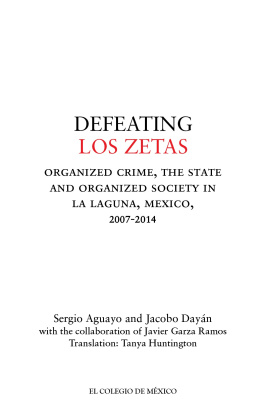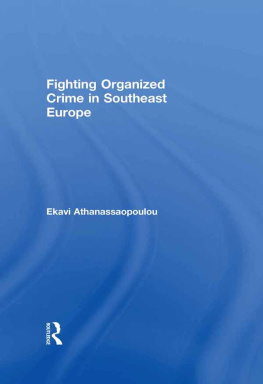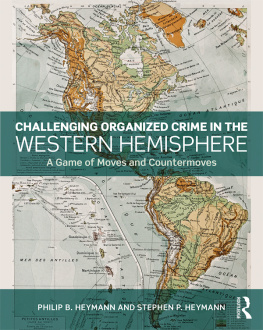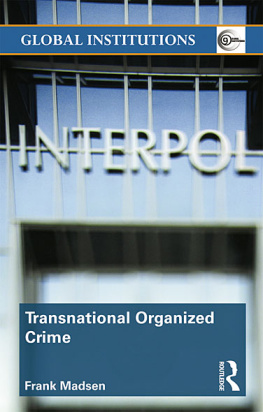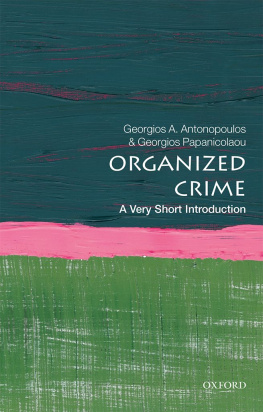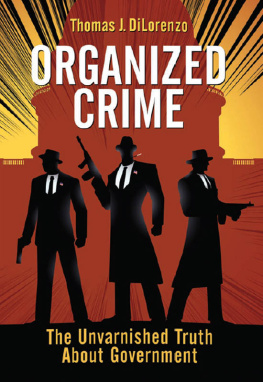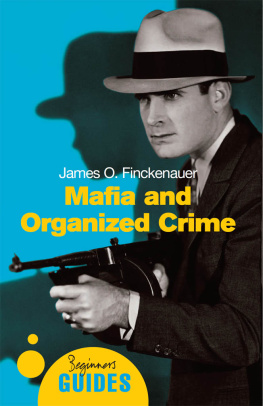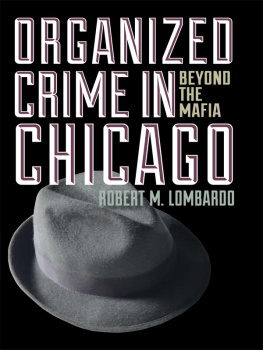Table of Contents
Acknowledgements and List of Interviewees
1. Research goals (and several caveats)
2. Cartel violence
3. The official strategy
4. Mass media
5. The business community
6. The victims and their organizations
7. Clandestine cremation sites and extermination zones
8. The Downfall of Los Zetas
9. Final reflections
Annexes
1. Major violent events in La Laguna
2. Tables of homicides and missing persons in La Laguna
3. Sites testing positive for bone remains located by Grupo Vida
4. Files reviewed
5. Major finds at clandestine cremation sites and extermination zones
6. Fragmentation of Los Zetas
7. Requested files that were not made available to us
In March 2016, El Colegio de Mxico signed an agreement with the Comisin Ejecutiva de Atencin a Vctimas ( ceav ) presided over by Dr. Jaime Rochn, who was decisive in the government of Coahuilas delivery of judicial files, essential research materials for State of Neglect and The Zeta Yoke. We would like to recognize his support and his commitment to clarifying the facts. For this research (completed in 2019), we were unable to access all of the judicial files we requested in a timely manner. The main wall of silence we came across was raised by the Fiscala General de la Repblica ( fgr ).
This research was made possible by the support of the ceav and the Ford Foundation, and completed with the collaboration of the Academia Interamericana de Derechos Humanos from the state of Coahuila. We also relied on the participation of the state government of Coahuila as well as the state attorney generals office, victims associations, and El Siglo de Torren . The following persons and institutions took part in our investigation:
Contributors to our research in Mexico City
Alfonso David Aparicio Bolaos
Anuar Israel Ortega Galindo
Cristina Antnez Moreno
Data Cvica
Georgina Romero Fuentes
Ivn Edai Espinosa Russi
Mnica Gabriela Maldonado Daz
Virginia Arellano
Zyanya Valeria Hernndez Almaguer
Contributors to research in La Laguna
Javier Garza Ramos
Francisco Rodrguez
Contributors to image mapping in La Laguna and Ciudad de Mxico
Ivn Corpus
Len Ruiz Chvez
Mariano de Carli
Rafael Adrin Bucio
Walter Nicols Doehner Soriano
Especially relevant institutions and organizations
Academia Interamericana de Derechos Humanos (Luis Efrn Ros and Irene Spigno)
Fiscala de personas desaparecidas de Coahuila (Jos ngel Herrera Cepeda)
Grupo Vida (Silvia Ortiz)
Lantia Consultores (Eduardo Guerrero)
List of interviewees
Adelaido Flores Daz (various positions at the Direccin de Seguridad Pblica de Torren 2009-2011 and Director 2011-2017, State Coordinator of the Laguna region since 2018). Interviewed by Jacobo Dayn.
Alejandro Hernndez (former reporter for Televisa). Interviewed by Francisco Rodrguez.
Alejandro Hope (former member of Cisen). Interviewed by Sergio Aguayo and Jacobo Dayn.
Alma Islas (Participacin Ciudadana 29). Interviewed by Javier Garza Ramos and Jacobo Dayn.
Armando Moreno (former journalist for Multimedios, Milenio and Express ). Interviewed by Francisco Rodrguez.
Arturo Aguilar (former journalist for Milenio and Coahuilteca Medios). Interviewed by Francisco Rodrguez.
Daniel Castellanos (state trooper in the La Laguna region of Coahuila, 1999-2012). Interviewed by Francisco Rodrguez.
Edna Jaime (Director of Mxico Evala). Interviewed by Sergio Aguayo and Jacobo Dayn.
Eduardo Olmos (Mayor of Torren, 2010-2013). Interviewed by Javier Garza Ramos.
Fernando Vela ( mp officer in the homicide division of the pgj Laguna, 2002-2013). Interviewed by Francisco Rodrguez.
Guillermo Valds Castellanos (Gea Consultores and former director of Cisen). Interviewed by Sergio Aguayo.
Javier Canales (former cameraman for Multimedios). Interviewed by Francisco Rodrguez.
Jorge Tello Pen (Consultora Madison and former director of Cisen). Interviewed by Sergio Aguayo and Jacobo Dayn.
Jos ngel Prez (Mayor of Torren, 2006-2009). Interviewed by Javier Garza Ramos and Jacobo Dayn.
Luis Morales (former reporter of El Siglo de Torren ). Interviewed by Jacobo Dayn.
Marco Zamarripa (Consejo Cvico de las Instituciones Laguna). Interviewed by Javier Garza Ramos.
Mara de la Luz Lpez (activist demanding justice for missing persons, known in Spanish as desaparecidos ). Interviewed by Jacobo Dayn.
Miguel ngel Riquelme (Mayor of Torren, 2013-2016, and Governor of Coahuila, 2017- ). Interviewed by Javier Garza Ramos.
Miguel Mery (Secretary of the Ayuntamiento de Torren, 2010-2013). Interviewed by Javier Garza Ramos and Jacobo Dayn.
Miriam Daniela Arreola (Grupo Vida). Interviewed by Jacobo Dayn.
Norma Patricia Albino (Grupo Vida). Interviewed by Jacobo Dayn.
Oscar Snchez Viesca (Grupo Vida). Interviewed by Jacobo Dayn.
Ricardo Rebollo Mendoza (Mayor of Gmez Palacio, 2007-2009). Interviewed by Javier Garza Ramos and Jacobo Dayn.
Rubn Moreira (Governor of Coahuila, 2011-2017). Interviewed by Sergio Aguayo.
Sandra Silva (former reporter of Noticias, Zcalo , La I, El Siglo de Torren ). Interviewed by Francisco Rodrguez.
Silvia Ortiz (Grupo Vida). Interviewed by Jacobo Dayn.
Four interviewees who asked to remain anonymous.
One of our missions at the Seminar on Violence and Peace includes contrasting the pessimistic tone of nearly all stories regarding criminal violence with success stories. Such is the case of La Laguna, where government institutions and civic organizations coincided in their diagnostics and concrete public policies; the result has been a sustained decrease in the number of homicides and disappearances. There are issues still pending, of course, but in this text, we explain the underlying causes of their accomplishment.
In 2016, we began to research how organized crime, State institutions and society had interacted in Coahuila. First, we studied the Allende massacre, then the Piedras Negras penitentiary, and in 2020, we completed the present report regarding events in places like La Laguna, a territory where a fierce war was waged between Los Zetas, El Cartel de Sinaloa, and their respective allies. Above all, we were interested in understanding the following:
a) The logic behind the systemic brutality employed by Los Zetasthe most violent carteland how the organization was beheaded and fragmented;
b) The reasons why the number of homicides and disappearances were reduced substantially and a dialogue established between victims organizations and the State government, which has been fruitful in terms of legislation and public policies that are beneficial, but could be improved, given that levels of impunity continue to be elevated; and,

